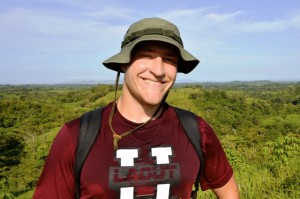By Sean Grim ’14
Robyn Henderek ’15 (Titusville, N.J.) and Wesley Von Dassow ’14 spent their summer vacation waist deep in Panamanian rivers, armed with rock hammers and magnetic compasses.

Robyn Henderek ’15 on site in Panama
As interns with the Smithsonian Tropical Research Center in Panama City, Henderek, a double major in geology and anthropology & sociology, and Von Dassow, a geology graduate, were responsible for collecting fossils unearthed by the Panama Canal Expansion Project.
Henderek, Von Dassow, and their Smithsonian colleagues analyzed bedrock representing Panama before, during, and after the joining of North and South America 3-4 million years ago. They sought evidence in fossils as to whether the migration of flora and fauna across the land bridge of the continents affected their biodiversity.
According to Henderek, who is also a member of the swimming and diving team, they found an average of about a dozen fossils per day, ranging from turtle shells to the teeth of the extinct ancestors of rhinos, camels, and horses. After retrieving a fossil, Von Dassow and Henderek returned to their base camp, where they catalogued the item in the Smithsonian database, meticulously cleaned the structure, and then shipped the fossil to the Florida Museum of Natural History, the Smithsonian’s partner organization on the project.

Wesley Von Dassow ’14 in Panama
The two Leopards also spent nearly a month in the tropical rainforest of the Azuero Peninsula, working alongside students from the Universidad de los Andes in Bogota, Colombia. They helped to create a geologic map of the peninsula, collect core samples for Paleomagnetic analysis, and catalogue more fossils. The rarest of their finds was a seven-inch tooth of a Megalodon, the prehistoric ancestor of the Great White Shark.
The pioneering fieldwork solidified Henderek and Von Dassow’s desire to pursue graduate degrees in geology.
“We are getting to know how to conduct our own research in the field with very few tools,” Henderek says. “We are seeing real science done in the field.”


3 Comments
“Think tectonically, map regionally”, sums up what geologists can do when they make geological maps and cross-sections that cover wide areas. They start to see how an extensive area is put together as a result of great blankets of lava flows and alluvial sediments. Fossil ages inform decisions about how the layers are arranged. That is a sophisticated piece that gives a better picture of the geology, especially where thick vegetation obliterates geological contents. Props to the Lafayette geology group who got chances to do this special work.
One of these students, she’ll remember who, a long time ago, once misplaced a dental appliance after a post concert dinner at a Princeton University campus church. Her grand parents, mother and herself “explored” the contents of all the waste containers after that dinner to recover this modern fossil. We collectively failed to find it. But the lesson was learned to keep looking and to gather,sort, clean and catalog all the findings.
So carry on the good work, we expect the very best of you.
GP
Comments are closed.